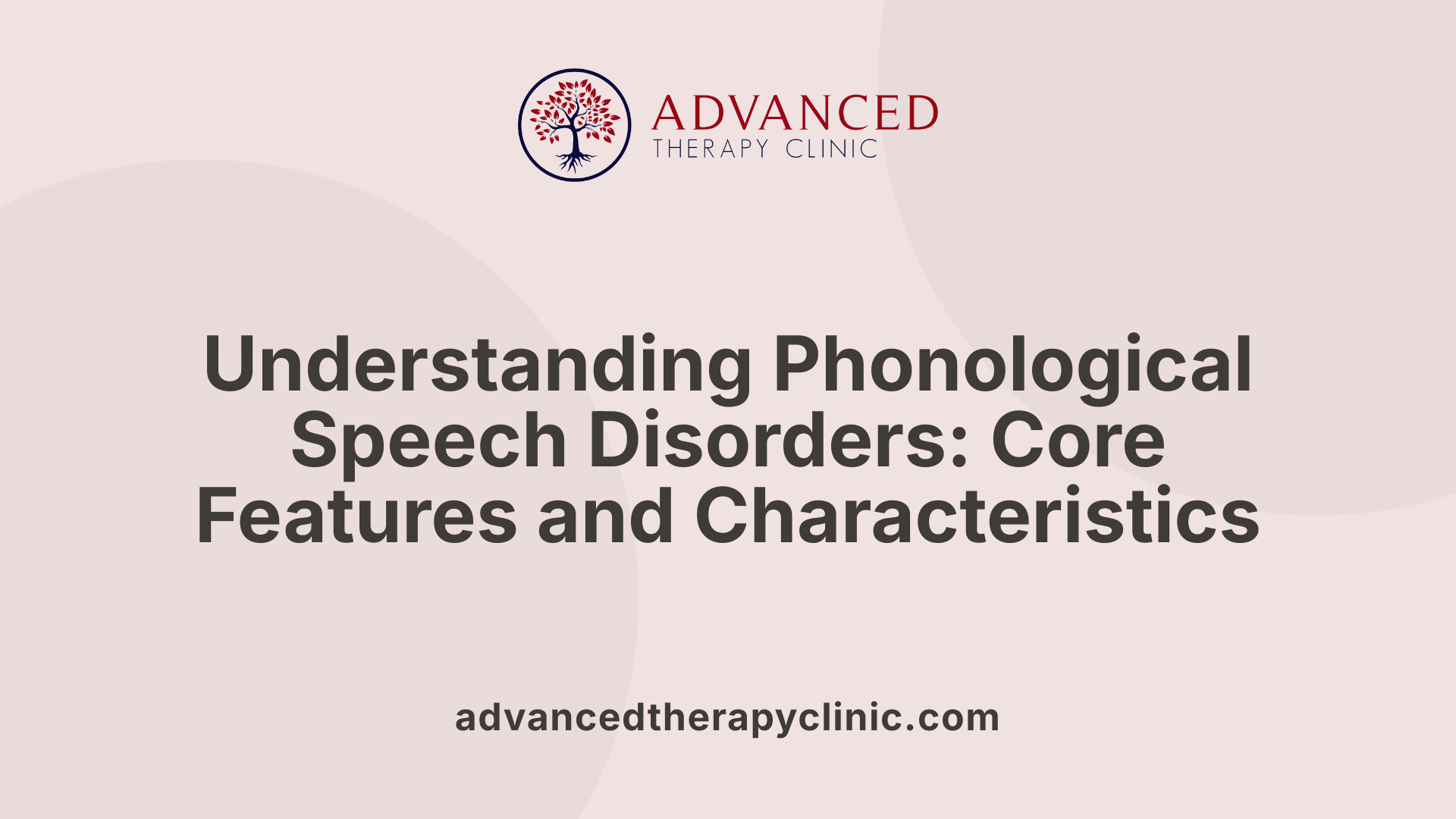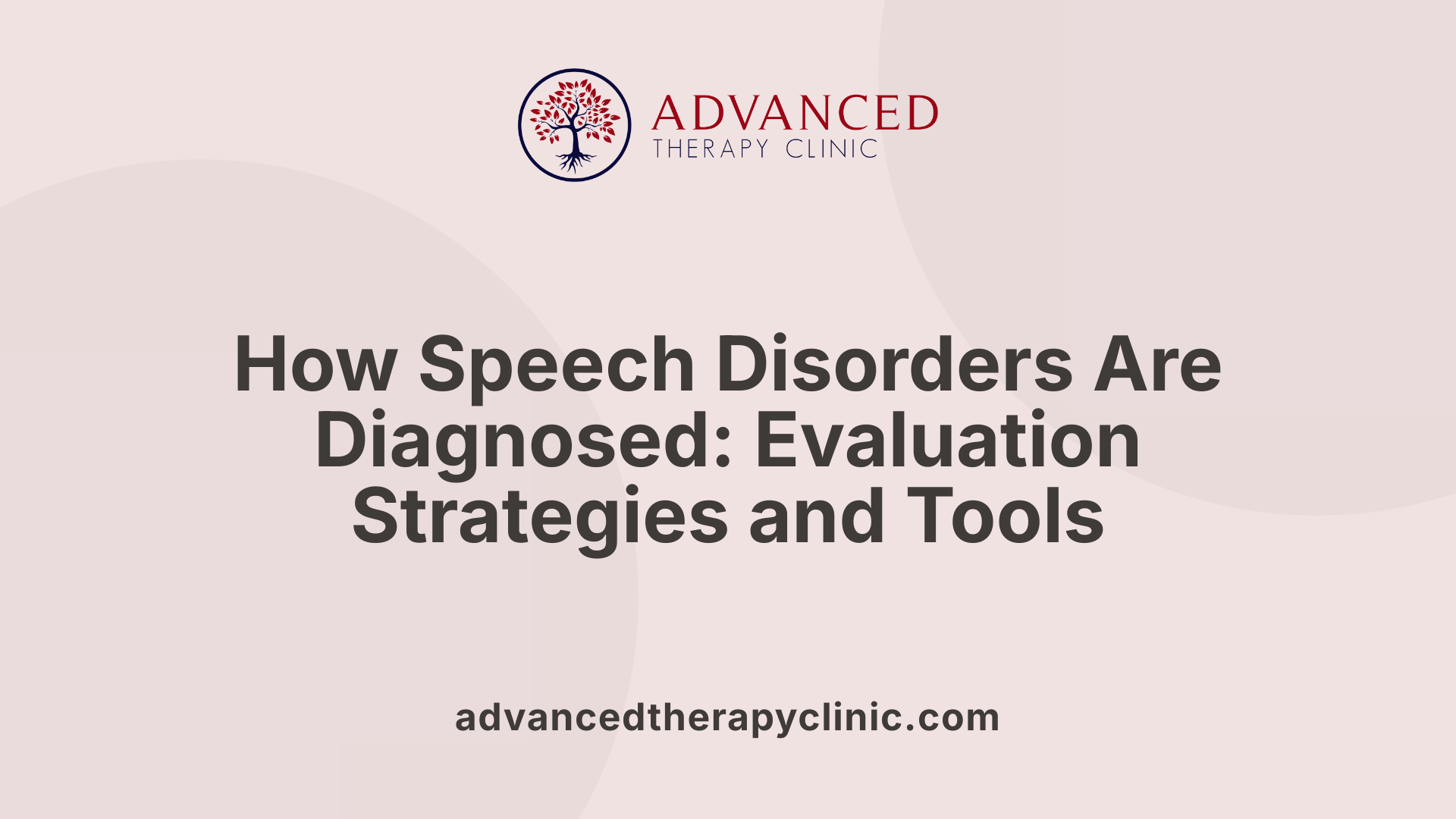What Is Phonological Speech Disorder


Introduction to Phonological Speech Disorder
Phonological speech disorder is a common communication challenge affecting many children, characterized by difficulties in understanding and applying the sound patterns that comprise language. Unlike simple articulation errors, this disorder involves systemic issues with sound organization, which can have significant implications on a child's speech clarity, social interactions, and literacy development. Recognizing the core characteristics, causes, signs, and treatment options is essential for early intervention and ensuring effective communication skills.
Defining Phonological Speech Disorder and Its Core Features

What is a phonological speech disorder, and what are its core characteristics?
A phonological speech disorder is a type of difficulty related to how children understand and use the sound system of their language. These children are aware of what they want to say but struggle with organizing and applying sound patterns correctly in words. Unlike articulation disorders, which involve the physical ability to produce specific sounds, phonological disorders relate to the mental rules governing sound combinations.
Children with this disorder often produce systematic errors in speech, such as substituting sounds, omitting certain consonants, or simplifying complex words by reducing syllables. These patterns, called phonological processes, tend to persist longer than expected for their age, making their speech harder to understand.
The core features include inconsistent or predictable mistakes, like leaving out sounds at the beginning or end of words, replacing certain sounds with others, or only using one syllable when a longer word is expected. For example, a child might say "doe" instead of "go" or omit the final consonant in words.
These speech patterns can affect a child's ability to communicate effectively, especially in social and educational settings. Early assessment and intervention with speech therapy are vital. Therapy helps children learn the correct sound patterns and improve their clarity, supporting better social interaction and literacy development.
Overall, a phonological disorder involves difficulty with the rules and patterns of speech rather than physical sound production, impacting both communication skills and learning outcomes.
Causes and Contributing Factors of Phonological Speech Disorders

What are the causes and contributing factors of phonological speech disorders?
The development of phonological speech disorders is influenced by a variety of factors, although in many cases, the precise cause remains unknown. Genetic predisposition plays a significant role; children often have relatives who have experienced speech and language difficulties, indicating a hereditary component.
Developmental delays and early childhood risks also contribute to the disorder. Factors such as hearing loss—particularly from middle ear infections like otitis media—can impair auditory feedback essential for normal speech development. Brain injuries or neurological conditions may disrupt the areas responsible for processing and organizing speech sounds.
Environmental influences are equally important. Limited language exposure, poor speech modeling at home, or exposure to toxins and infections during pregnancy can impact phonological development. Children born preterm or with complications during the prenatal and perinatal periods may also be more vulnerable.
In summary, causes of phonological speech disorders are multifaceted, combining genetic, biological, and environmental elements. While some children develop these difficulties without a clear reason, understanding these factors helps inform early diagnosis and tailored intervention strategies.
| Factor Type | Examples | Additional Details |
|---|---|---|
| Genetic predisposition | Family history of speech/language problems | Hereditary factors increase risk |
| Developmental delays | Speech and language development delays | Usually identified in early childhood |
| Neurological and biological | Hearing loss, brain injury, neurological conditions | Can interfere with sound processing and organization |
| Environmental influences | Limited language exposure, toxins, infections | Affects auditory and speech development |
| Prenatal factors | Premature birth, maternal health issues | Can impact brain and speech organ development |
Understanding these contributing factors underscores the importance of early assessment and intervention. Recognizing the multifactorial nature of phonological disorders allows clinicians to develop comprehensive treatment plans tailored to each child's needs.
Recognizing the Symptoms and Signs of a Disorder

What symptoms and signs indicate a phonological speech disorder?
Children with a phonological disorder often display a range of speech errors and irregular patterns that make their speech less clear. One of the primary signs is inconsistent speech production, meaning the child may say the same word differently during different instances. For example, they might pronounce a word correctly one time and incorrectly another.
Another common feature is difficulty with complex words or multisyllabic words. These children might omit consonants, simplify words by repeating syllables, or swap sounds within words, which falls outside typical developmental patterns. For instance, they may leave out sounds they can normally pronounce in other contexts, like saying “at” instead of “sat,” or replacing a “k” sound with a “t,” which is not age-appropriate.
In terms of intelligibility, children with phonological issues often have reduced clarity in speech. This can make their words hard for family members and others to understand, especially in noisy or unfamiliar environments. They tend to use predictable error patterns such as backing (producing sounds towards the back of the mouth), initial consonant deletion (leaving off the first sound), or substitution errors like replacing one sound with another.
More specifically, signs include:
- Use of unusual or inconsistent error patterns that persist beyond the typical age.
- Difficulty with multisyllabic words and complex phoneme combinations.
- Dropping consonants or simplifying words by using only one syllable when more are expected.
- Rearranging sounds or repeating syllables to produce simpler versions of words.
These speech difficulties are not just isolated issues but tend to form the basis of broader language challenges. Children’s speech may be difficult to decipher, impacting their communication abilities and social interactions.
Early identification of these signs can lead to effective intervention. Speech therapy that targets phonological rules and sound organization can significantly improve clarity. When these issues are left untreated, they may cause longer-term problems, such as difficulties in reading and writing, which are closely linked to phonological skills.
In summary, parents and caregivers should be alert to a child's inconsistent speech errors, difficulty with complex and multisyllabic words, and overall reduced speech clarity. Recognizing these signs early allows for timely assessment and appropriate support to improve language development and communication skills.
Diagnosis Methods and Evaluation Strategies

How are phonological speech disorders diagnosed?
Phonological speech disorders are diagnosed through comprehensive evaluations performed by a qualified speech-language pathologist. This process involves multiple approaches to accurately identify the nature and severity of the child's speech patterns.
First, speech assessments include both formal standardized tests and informal observations. Standardized tools, such as the Arizona-4 scale, are used to measure speech sound production, intelligibility, and phonological processes systematically. These tests help determine if error patterns are typical or if they persist beyond the expected developmental age.
During informal observations, clinicians listen to speech samples in various contexts, like single words and connected speech. They analyze error patterns, such as substitutions, deletions, and distortions, and assess whether these errors are consistent or inconsistent across different words.
Additional measures include stimulability testing, which evaluates whether the child can produce correct sounds when prompted, and speech perception tests to gauge how well the child understands speech sounds. An important aspect of diagnosis is assessing speech intelligibility—the clarity of speech and how easily others can understand the child.
Clinicians also consider the child's linguistic background, dialect, and developmental stage to distinguish speech sound disorders from typical variations. During the evaluation, other conditions such as hearing loss, neurological issues, or cognitive impairments are ruled out. This thorough approach ensures an accurate diagnosis, guiding effective intervention strategies.
By combining these assessment methods, speech-language pathologists can determine whether a child has a phonological disorder, its type (consistent or inconsistent), and plan suitable treatment options to improve speech clarity and language skills.
Treatment and Intervention Strategies

What are the treatment and intervention options for managing phonological speech disorders?
Managing phonological speech disorders involves various strategies designed to improve a child's speech clarity and understanding of sound patterns. Treatment approaches are tailored to each child's specific error patterns, age, and severity of the disorder.
One of the most common methods is traditional articulation therapy, which focuses on teaching correct sound production. This is often combined with phonological process therapy, targeting specific error patterns such as simplifications or substitutions. For instance, minimal pairs therapy uses pairs of words that differ by only one sound to help the child differentiate and produce correct sounds.
Other techniques include maximal opposition therapy, which contrasts highly different sounds to establish correct patterns, and the cycle approach, where targeted patterns are practiced intensively over specific periods. Phonotactic therapy aims to strengthen the child's understanding of permissible sound combinations.
These therapies typically follow three phases: establishing correct sounds or patterns, encouraging generalization of these sounds in daily speech, and maintaining improvements over time. Speech-language pathologists select target sounds based on factors like developmental norms and the impact on intelligibility.
Incorporating naturalistic speech interventions can make therapy more engaging and functional. Feedback modalities such as visual cues, tactile prompts, ultrasound feedback, and others can help children learn correct articulation.
Family involvement is crucial; home practice and exercises are recommended to reinforce therapy gains. When appropriate, group therapy or online sessions can also support generalization and provide additional practice opportunities. Early and consistent intervention often leads to significant improvements, reducing long-term communication and academic difficulties.
Distinguishing Phonological Disorders from Other Speech Difficulties
How do phonological speech disorders differ from articulation disorders?
Phonological disorders and articulation disorders are two distinct types of speech sound problems. Children with articulation disorders have trouble physically producing specific sounds correctly. This can include lisps, omissions, distortions, or substitutions of sounds, often affecting only a few speech sounds. These errors are motor-based, stemming from difficulties in movement and coordination of the speech organs.
In contrast, phonological disorders involve the child's inability to understand and apply the rules governing sound patterns in language. Children with phonological issues produce many sounds correctly but use them in incorrect patterns or processes, such as deleting the final consonant or replacing sounds across multiple words. These errors reflect a problem with the cognitive and linguistic organization of sounds, not just motor skills.
Assessment of these conditions differs as well. Speech-language pathologists evaluate articulation by observing how sounds are physically made, while phonological assessment focuses on identifying error patterns and underlying speech process rules.
Treatment strategies are tailored to these differences: motor exercises and practice are common for articulation disorders, and phonological process suppression and linguistic strategies are used for phonological disorders.
Impact on speech intelligibility
Children with phonological disorders often have reduced speech clarity, leading to difficulty being understood by others. When patterns of errors persist past the typical age, this can hinder effective communication, social interactions, and academic success.
In comparison, children with articulation disorders may still be understood most of the time, especially if errors are limited or consistent. Therefore, phonological issues tend to have a more widespread impact on overall speech intelligibility and language development.
Underlying cognitive and linguistic aspects
At the core, phonological disorders stem from difficulties in the mental representation and rule-based organization of speech sounds. This disruption can extend into broader language skills, affecting phonological awareness, reading, and spelling.
Conversely, articulation disorders are mainly motor skill problems, with the brain’s motor pathways or physical structures impacting how specific sounds are produced. While articulation issues can overlap with language problems, phonological disorders involve deeper cognitive-linguistic processes.
Understanding these differences is essential for choosing the right treatment and support for children facing speech challenges, enabling targeted interventions that address the specific nature of their disorder.
Prognosis, Curing, and the Importance of Early Intervention
Can phonological disorders be cured, or do they resolve on their own?
Many children with mild phonological disorders tend to resolve their speech errors naturally by around age 6 or 7. This natural resolution often occurs as part of typical speech development, especially when children receive early support and are given opportunities to practice clearer speech. For these children, their ability to organize sounds and understand phonological rules improves over time without extensive therapy.
However, not all phonological disorders will improve on their own. Severe cases, or those that persist beyond the typical age of speech development milestones, often require intervention from a speech-language pathologist. Early therapy aims to help children unlearn incorrect sound patterns and develop correct speech habits.
The success of treatment depends on several factors, including the severity of the disorder, the child's age, and how quickly intervention is initiated. Early intervention is crucial; the earlier therapy begins, the better the outlook for improving speech clarity and social interactions.
While some children with phonological disorders may achieve speech that is nearly normal, others with more severe or persistent issues might continue to experience challenges in intelligibility. Nonetheless, with appropriate and timely therapy, many children see substantial improvements, leading to better communication skills, academic performance, and social participation.
Ultimately, it is possible for phonological disorders to be cured or significantly reduced through early and targeted intervention, highlighting the importance of prompt assessment and treatment when speech difficulties are noticed.
Final Thoughts on Addressing Phonological Speech Disorders
Understanding phonological speech disorder is crucial for early identification and intervention. This disorder's impact on communication, literacy, and social interaction underscores the importance of timely diagnosis by speech-language pathologists and the implementation of effective therapy methods. Although many cases resolve naturally or with therapy, perseverance and family support are vital for achieving successful outcomes. Raising awareness about the differences from articulation disorders and the long-term benefits of early treatment can significantly improve the lives of children facing these challenges, helping them to develop clear and confident speech.
References
- Phonological Disorder: Types, Signs & Treatment - Cleveland Clinic
- Phonological disorder: MedlinePlus Medical Encyclopedia
- Speech Sound Disorders: Articulation and Phonology - ASHA
- Speech problems – articulation and phonological disorders
- [PDF] Phonological disorder
- Phonological Process Disorders - Nicklaus Children's Hospital
- Phonological disorder - Manchester - SLT for Kids
- Phonological Disorder vs Articulation Disorder: What's the Difference?
- Clinical information on speech sound disorders - RCSLT
- What Are Phonological Disorders, and How Are They Treated?
Recent articles

Expressive Speech Delay 2-Year-Old
Understanding and Addressing Expressive Speech Delay in Toddlers

How Speech Recognition Works
Unlocking the Power of Speech Recognition in Therapy and Healthcare

Autism and Head Size
Understanding the Complex Relationship Between Autism and Head Size

Occupational Therapy in Autism
Enhancing Independence and Quality of Life Through Occupational Therapy in Autism

Do Autistic People Understand Sarcasm?
Navigating the Nuances: Understanding Sarcasm and Social Communication in Autism

Autism Routines
Crafting Effective Daily Structures for Children with Autism

